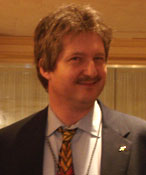By Candice Nunez, NSS ISDC Reporter, courtesy QGITS
 Gary Barnhard is a robotic space systems engineer whose professional work includes a wide range of robotic, space, and computer systems engineering projects. Gary has received a Bachelor of Science in Engineering from the University of Maryland in 1982 combining Aerospace Engineering, Materials Science, with graduate work in science policy, solar physics, and artificial intelligence. He was awarded a grant to participate in NASA’s Graduate Student Researchers Program under the auspices of NASA Goddard Space Flight Center (GSFC) and the UMCP Aerospace Engineering Department. Some of his work included supporting the development of the Space Station User Information System Requirements. Over the last 34 years he has been extensively involved in the space advocacy community.
Gary Barnhard is a robotic space systems engineer whose professional work includes a wide range of robotic, space, and computer systems engineering projects. Gary has received a Bachelor of Science in Engineering from the University of Maryland in 1982 combining Aerospace Engineering, Materials Science, with graduate work in science policy, solar physics, and artificial intelligence. He was awarded a grant to participate in NASA’s Graduate Student Researchers Program under the auspices of NASA Goddard Space Flight Center (GSFC) and the UMCP Aerospace Engineering Department. Some of his work included supporting the development of the Space Station User Information System Requirements. Over the last 34 years he has been extensively involved in the space advocacy community.
QGITS (an online publication for STEM students) had the opportunity to chat with Gary Barnhard who is speaking on the panel at this year’s ISDC National Space Society Conference May 14-18 on the Space Solar Power track.
QGITS: You have an extensive background in space related educational programs and working with different organizations in the space field, how did you get started in the space advocacy community?
Gary Barnhard: For me I had an interesting habit of hanging out in the Nasa headquarters library back in junior high school and early high school and one day the librarian there who I was good friends with came up to me and said you know Gary there is something you need to read and she handed me a copy of the publication “Physics Today” and it had an article by this interesting Physicist in it from Princeton named Dr. Gerard K. O’Neill dealing with the issue of “Was the surface of the planet really the best home for an expanding technological civilization?” (Physics Today, September 1974). I had wanted to be an Astronaut since I became aware watching the Gemini launches go up in space. Unfortunately, despite memorizing the eye chart, it was clear I could never pass a real vision test. What Dr. O’Neill offered was the vision of a positive future that I could help with, helping to provide for space development and build large space structures and space stations. That’s how I went on to.. what turned out to be a career in robotics space systems engineering.
QGITS: Can you tell us about the projects you have worked on?
Gary Barnhard: I started off as part of the Solar Maximum Mission (SMM) which was a satellite doing solar observations in the early 80’s. I provided real time images of the sun in hydrogen alpha to the control room as part of the cooperative research in physics & astronomy agreement between University of Maryland and NASA Goddard. I went on from there as a NASA grantee in NASA graduate researchers program where I was working on the applications of knowledge based systems to the domain of spacecraft systems engineering. I had the opportunity to be a part of the Space Station Program Mission Requirements Working Group in the original efforts to breathe life into the space station program and from there I ended up on the contractors side of the fence working with Goddard Space Station Office.
QGITS: What are you addressing on the panel for the Space Solar Power Track (SSP)?
Gary Barnhard: There are five sessions: 1 – Overview Perspectives; 2 – SSP Concepts, research and technology development; 3 – Supporting Infrastructure; 4 – Fostering international cooperation – focusing the government/industry/NGO mix; and, 5 – SSP Industry Day. One of the more unique sessions is “space solar power industry day” which is intended to draw out where help is needed ..once a upon a time NASA used to have these events called “industry days” where technical people working a program would explain where the problems are and where we need help. The idea being to view the contractor community as resource to help solve the tough problem a program faces. Today space solar power is tough systems engineering problem but is one of the few options that we can potentially bring to the table that can scale to not only make a dramatic contribution to the energy to the United States but to the world.
QGITS: Lastly, why do people attend the ISDC conference?
Gary Barnhard: We need to be about the question of not just thinking about the future we like to see come to pass but what are we doing to make it real? The National Space Society is effectively the big tent space advocacy organization with the goal trying to provide a path to engagement in space for anyone that has an interest. Regardless of whether it is just a vicarious interest, those who wish to be advocates for helping make things happen, and/or those who actually who want to be involved in building things and making it happen directly. The ISDC pulls together a diverse community of individuals across all disciplines and perspectives.



















1 thought on “ISDC Space Solar Power Track: Gary Barnhard”
Recent advances in solar concentrators and space solar sails mean we *currently* have the capability to do economical space solar power.
Bob Clark